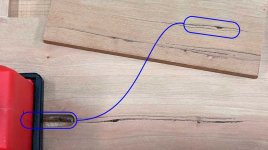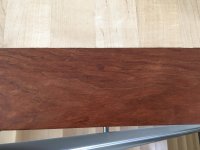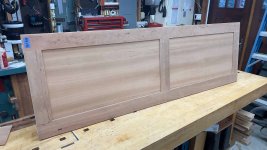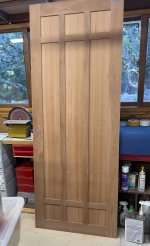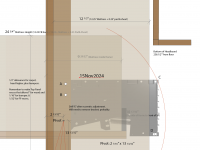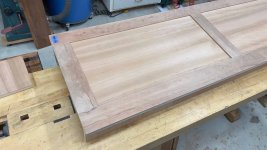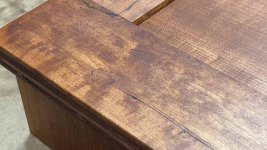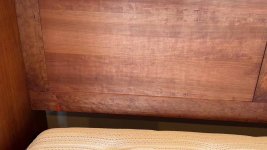smorgasbord
Member
Blew it, that is. I've seen other people do it, but I've been lucky/careful until today when I dominoed too deep and went through my piece:
[attachimg=1]
Decided to glue up anyway and then decide how to address. So, I think my options are:
1) Glue a contrasting wood in place. This piece is all cherry so that's out.
2) Glue a piece from the same board (pictured, even has the same grain) in. Then I'll need to think about the best way to mill the piece I need. I'm thinking using my CNC to cut a tapered wall plug that I'll hammer in with glue.
3) This is a fake frame and panel (a headboard). The "frame" is really just a ¼" thick piece of wood glued onto a sheet of plywood. I could try to cut away the entire "frame" piece with tablesaw and router and make and glue a replacement. But, that seems like a ton of work, and I'd have to be good to get the three joints (there's a crosspiece in the middle) tight again. This is probably the "right" way to fix this.
4) I could rip a groove the entire length of the frame and the width of the domino (6mm) and glue a contrasting wood in. At least way it's not a plug, it's an inlay.
5) I could rip away that inch or so of the "frame" so the domino hole is gone and glue another long piece in. That way it would look like the "frame" itself was a glue-up. Not the best look, but most non-woodworkers wouldn't notice or care. I could even make this piece an ⅛" or 3/16" thicker so it would look like I wanted to beef up the frame at the edge (this is at the bottom of the headboard, which is about 64" wide and 22" tall).
Any other ideas or a vote on these?
TIA
[attachimg=1]
Decided to glue up anyway and then decide how to address. So, I think my options are:
1) Glue a contrasting wood in place. This piece is all cherry so that's out.
2) Glue a piece from the same board (pictured, even has the same grain) in. Then I'll need to think about the best way to mill the piece I need. I'm thinking using my CNC to cut a tapered wall plug that I'll hammer in with glue.
3) This is a fake frame and panel (a headboard). The "frame" is really just a ¼" thick piece of wood glued onto a sheet of plywood. I could try to cut away the entire "frame" piece with tablesaw and router and make and glue a replacement. But, that seems like a ton of work, and I'd have to be good to get the three joints (there's a crosspiece in the middle) tight again. This is probably the "right" way to fix this.
4) I could rip a groove the entire length of the frame and the width of the domino (6mm) and glue a contrasting wood in. At least way it's not a plug, it's an inlay.
5) I could rip away that inch or so of the "frame" so the domino hole is gone and glue another long piece in. That way it would look like the "frame" itself was a glue-up. Not the best look, but most non-woodworkers wouldn't notice or care. I could even make this piece an ⅛" or 3/16" thicker so it would look like I wanted to beef up the frame at the edge (this is at the bottom of the headboard, which is about 64" wide and 22" tall).
Any other ideas or a vote on these?
TIA


